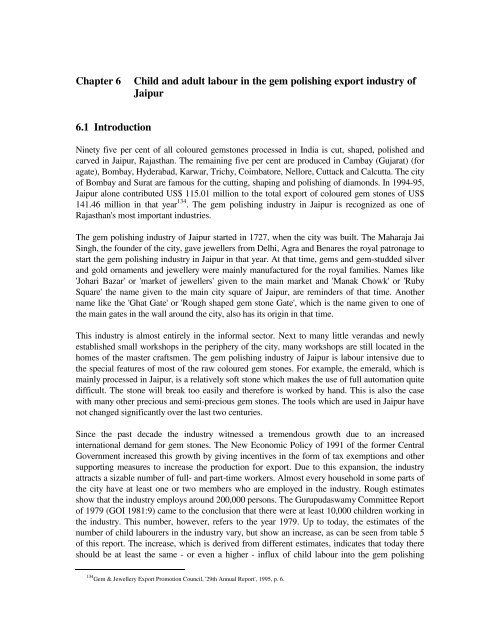You also want an ePaper? Increase the reach of your titles
YUMPU automatically turns print PDFs into web optimized ePapers that Google loves.
Chapter 6<br />
<strong>Child</strong> <strong>and</strong> <strong>adult</strong> <strong>labour</strong> <strong>in</strong> <strong>the</strong> <strong>gem</strong> polish<strong>in</strong>g <strong>export</strong> <strong>in</strong>dustry <strong>of</strong><br />
Jaipur<br />
6.1 Introduction<br />
N<strong>in</strong>ety five per cent <strong>of</strong> all coloured <strong>gem</strong>stones processed <strong>in</strong> <strong>India</strong> is cut, shaped, polished <strong>and</strong><br />
carved <strong>in</strong> Jaipur, Rajasthan. The rema<strong>in</strong><strong>in</strong>g five per cent are produced <strong>in</strong> Cambay (Gujarat) (for<br />
agate), Bombay, Hyderabad, Karwar, Trichy, Coimbatore, Nellore, Cuttack <strong>and</strong> Calcutta. The city<br />
<strong>of</strong> Bombay <strong>and</strong> Surat are famous for <strong>the</strong> cutt<strong>in</strong>g, shap<strong>in</strong>g <strong>and</strong> polish<strong>in</strong>g <strong>of</strong> diamonds. In 1994-95,<br />
Jaipur alone contributed US$ 115.01 million to <strong>the</strong> total <strong>export</strong> <strong>of</strong> coloured <strong>gem</strong> stones <strong>of</strong> US$<br />
141.46 million <strong>in</strong> that year 134 . The <strong>gem</strong> polish<strong>in</strong>g <strong>in</strong>dustry <strong>in</strong> Jaipur is recognized as one <strong>of</strong><br />
Rajasthan's most important <strong>in</strong>dustries.<br />
The <strong>gem</strong> polish<strong>in</strong>g <strong>in</strong>dustry <strong>of</strong> Jaipur started <strong>in</strong> 1727, when <strong>the</strong> city was built. The Maharaja Jai<br />
S<strong>in</strong>gh, <strong>the</strong> founder <strong>of</strong> <strong>the</strong> city, gave jewellers from Delhi, Agra <strong>and</strong> Benares <strong>the</strong> royal patronage to<br />
start <strong>the</strong> <strong>gem</strong> polish<strong>in</strong>g <strong>in</strong>dustry <strong>in</strong> Jaipur <strong>in</strong> that year. At that time, <strong>gem</strong>s <strong>and</strong> <strong>gem</strong>-studded silver<br />
<strong>and</strong> gold ornaments <strong>and</strong> jewellery were ma<strong>in</strong>ly manufactured for <strong>the</strong> royal families. Names like<br />
'Johari Bazar' or 'market <strong>of</strong> jewellers' given to <strong>the</strong> ma<strong>in</strong> market <strong>and</strong> 'Manak Chowk' or 'Ruby<br />
Square' <strong>the</strong> name given to <strong>the</strong> ma<strong>in</strong> city square <strong>of</strong> Jaipur, are rem<strong>in</strong>ders <strong>of</strong> that time. Ano<strong>the</strong>r<br />
name like <strong>the</strong> 'Ghat Gate' or 'Rough shaped <strong>gem</strong> stone Gate', which is <strong>the</strong> name given to one <strong>of</strong><br />
<strong>the</strong> ma<strong>in</strong> gates <strong>in</strong> <strong>the</strong> wall around <strong>the</strong> city, also has its orig<strong>in</strong> <strong>in</strong> that time.<br />
This <strong>in</strong>dustry is almost entirely <strong>in</strong> <strong>the</strong> <strong>in</strong>formal sector. Next to many little ver<strong>and</strong>as <strong>and</strong> newly<br />
established small workshops <strong>in</strong> <strong>the</strong> periphery <strong>of</strong> <strong>the</strong> city, many workshops are still located <strong>in</strong> <strong>the</strong><br />
homes <strong>of</strong> <strong>the</strong> master craftsmen. The <strong>gem</strong> polish<strong>in</strong>g <strong>in</strong>dustry <strong>of</strong> Jaipur is <strong>labour</strong> <strong>in</strong>tensive due to<br />
<strong>the</strong> special features <strong>of</strong> most <strong>of</strong> <strong>the</strong> raw coloured <strong>gem</strong> stones. For example, <strong>the</strong> emerald, which is<br />
ma<strong>in</strong>ly processed <strong>in</strong> Jaipur, is a relatively s<strong>of</strong>t stone which makes <strong>the</strong> use <strong>of</strong> full automation quite<br />
difficult. The stone will break too easily <strong>and</strong> <strong>the</strong>refore is worked by h<strong>and</strong>. This is also <strong>the</strong> case<br />
with many o<strong>the</strong>r precious <strong>and</strong> semi-precious <strong>gem</strong> stones. The tools which are used <strong>in</strong> Jaipur have<br />
not changed significantly over <strong>the</strong> last two centuries.<br />
S<strong>in</strong>ce <strong>the</strong> past decade <strong>the</strong> <strong>in</strong>dustry witnessed a tremendous growth due to an <strong>in</strong>creased<br />
<strong>in</strong>ternational dem<strong>and</strong> for <strong>gem</strong> stones. The New Economic Policy <strong>of</strong> 1991 <strong>of</strong> <strong>the</strong> former Central<br />
Government <strong>in</strong>creased this growth by giv<strong>in</strong>g <strong>in</strong>centives <strong>in</strong> <strong>the</strong> form <strong>of</strong> tax exemptions <strong>and</strong> o<strong>the</strong>r<br />
support<strong>in</strong>g measures to <strong>in</strong>crease <strong>the</strong> production for <strong>export</strong>. Due to this expansion, <strong>the</strong> <strong>in</strong>dustry<br />
attracts a sizable number <strong>of</strong> full- <strong>and</strong> part-time workers. Almost every household <strong>in</strong> some parts <strong>of</strong><br />
<strong>the</strong> city have at least one or two members who are employed <strong>in</strong> <strong>the</strong> <strong>in</strong>dustry. Rough estimates<br />
show that <strong>the</strong> <strong>in</strong>dustry employs around 200,000 persons. The Gurupudaswamy Committee Report<br />
<strong>of</strong> 1979 (GOI 1981:9) came to <strong>the</strong> conclusion that <strong>the</strong>re were at least 10,000 children work<strong>in</strong>g <strong>in</strong><br />
<strong>the</strong> <strong>in</strong>dustry. This number, however, refers to <strong>the</strong> year 1979. Up to today, <strong>the</strong> estimates <strong>of</strong> <strong>the</strong><br />
number <strong>of</strong> child <strong>labour</strong>ers <strong>in</strong> <strong>the</strong> <strong>in</strong>dustry vary, but show an <strong>in</strong>crease, as can be seen from table 5<br />
<strong>of</strong> this report. The <strong>in</strong>crease, which is derived from different estimates, <strong>in</strong>dicates that today <strong>the</strong>re<br />
should be at least <strong>the</strong> same - or even a higher - <strong>in</strong>flux <strong>of</strong> child <strong>labour</strong> <strong>in</strong>to <strong>the</strong> <strong>gem</strong> polish<strong>in</strong>g<br />
134 Gem & Jewellery Export Promotion Council, '29th Annual Report', 1995, p. 6.


















